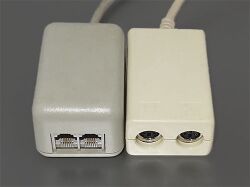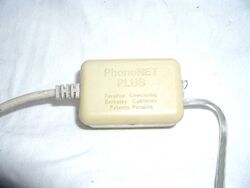PhoneNET
PhoneNET was an implementation of the AppleTalk networking physical layer created by Farallon Computing (now Netopia).
Instead of the shielded twisted pair wiring and three-pin mini-DIN connectors employed by Apple's LocalTalk implementation, PhoneNET uses standard four-conductor telephone (Category 1) patch cords and RJ-11 modular connectors.
Like LocalTalk, the maximum speed for data transfer was 230 kbit/s unless accelerating drivers were used to override the operating system's drivers. Unlike LocalTalk, which only supported a daisy chain topology, PhoneNET was principally used in star topologies over structured cabling plants.
Functionality

Unlike LocalTalk's four-wire grounded implementation, PhoneNET used a single twisted pair, or the outside two wires of a four-conductor flat cable.
As normal telephone equipment used the inside two wires, PhoneNET could share cabling with telephones, allowing both phone calls and networking over a single cable.
Superseded by
Though PhoneNET transceivers are still available from third parties for use on legacy Macintosh networks, no Apple computer or device has been made with the RS-422 mini-DIN-8 serial ports required for LocalTalk networking since the discontinuation of the Power Macintosh G3 in 1999.[citation needed]
(As of 2023), Apple devices use Ethernet or wireless networking.[citation needed]
External links
- PhoneNET User's Guide: Scribd - Internet Archive
- Schematics
- Photos
 |


